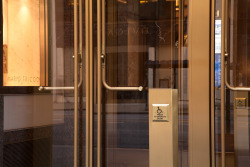Designing for Accessibility: The Importance of Entrance Solutions in ADA Compliance
According to Pew Research Center, there are 42.5 million Americans with disabilities – approximately 13 percent of the civilian population, excluding those in detention facilities or institutions housing those with disabilities. Therefore, creating entrances that adhere to the Americans with Disabilities Act (ADA) is not just a legal requirement, but a fundamental step towards fostering inclusivity in public spaces. ADA-compliant doors are designed to provide equal access to all individuals. This ensures that everyone, regardless of physical ability, can navigate public spaces with ease.
Public entrances must fulfill two crucial requirements: accessibility and aesthetics. Custom balanced doors integrated into an ADA-compliant design check both boxes, allowing specifiers to deliver an entrance system that makes a head-turning first impression and ensures effortless access for all individuals. Ellison Bronze, the creator of the custom crafted balanced door, plays a pivotal role in helping architects and designers meet ADA specifications when designing entrances for commercial projects.
Background: The Standards
The current ADA standards were published by the Department of Justice in September 2010 with Titles II and III. Title III of the ADA, which is a federal law, requires all newly constructed or retrofitted commercial places (or those of public accommodation) to be designed to prevent discrimination against people with disabilities.
These regulations adopted revised and enforceable accessibility standards called the 2010 ADA Standards for Accessible Design, otherwise known as “2010 Standards” or simply “Standards.” The 2010 Standards set minimum requirements for newly designed and constructed, or altered state and local government facilities, public accommodations, and commercial facilities to be readily accessible.
Among other items, the Standards included updated mandates for accessible routes, the minimum number of accessible entrances, door swing opening requirements, automatic and power-assisted door opening devices, handles and hardware, and more.
Accessible Entrances: The Details
At least 60% of public entrances must be accessible in new construction, in addition to entrances directly serving tenancies, parking facilities, pedestrian tunnels, and elevated walkways. “Public entrances” include all entrances except those that are restricted or that are used exclusively as service entrances.
Additional requirements apply to transit facilities and to entrances for inmates and detainees in judicial, detention, and correctional facilities.
In terms of size and function, at least one door serving each accessible room or space must meet the prescribed entrance accessibility requirements.
In addition, one active leaf of double-leaf doors is required to meet the criteria for clear width and maneuvering clearance. For designers, clear openings of doorways with swinging doors must be measured between the face of the door and the stop when open at 90 degrees. No projection into the clear width is permitted below 32 inches, which permits those in wheelchairs to comfortably navigate doorways. This is especially critical in vestibule areas or ramps with limited maneuvering space.
Check out the Ellison Bronze ADA Planning Guide for Entrances and Doors for the full details on designing ADA-compliant entrances.
Importance of ADA Compliance in Entrance Design
-
Inclusivity Matters
ADA compliance ensures that entrances cater to the diverse needs of individuals, regardless of their physical abilities. It goes beyond legality, promoting inclusivity and a sense of belonging in public spaces. When choosing Ellison, the organization’s custom balanced doors are each custom made at the company’s Falconer, NY, facility, meaning the doors can be specially designed (size, material, and more) to meet ADA standards.
-
Legal Imperative
Failure to comply to ADA standards not only results in legal repercussions but also hinders the goal of creating universally accessible environments. In fact, according to an article written by O8 Agency, “organizations and businesses can be fined up to $75,000 for a single ADA violation, raising that fine to $150,000 for additional violations.”
-
Enhanced User Experience
Accessible entrances contribute to an enhanced user experience for everyone. A well-designed entrance takes into account the diverse needs of all individuals through thoughtful ADA-compliant design. A properly designed entrance should be no more difficult to access for wheelchair users or those with mobility impairments than anyone else.
Ellison Bronze: An Active Role
-
Complete ADA Compliance
Ellison Bronze offers custom balanced doors designed as a complete system to meet the requirements of the latest ADA standards. By utilizing the proper balanced hardware and mounting locations, the doors not only ensure compliance but also seamlessly integrate into the overall design of an ADA-compliant entrance system.
-
Versatility in Design
The beauty of Ellison doors lies in their versatility. Architects and designers can choose from various design options, allowing them to create entrances that are both functional and visually appealing while adhering to ADA requirements.
Ellison doors can be manufactured from a number of hardwearing materials, such as stainless steel, bronze, extruded aluminum, and wood. Many Ellison balanced doors feature large expanses of tempered glass that allow natural light to permeate interior spaces to boost eco-friendliness. Tempered glass is up to five times stronger than annealed glass, further exhibiting the long-term durability that Ellison doors are known for.
-
Ellison Educational Resources
Ellison Bronze goes beyond just providing the products to meet compliance mandates. Ellison’s ADA Planning Guide for Entrances and Doors is a valuable resource for architects and designers, assisting teams planning entrances that comply with ADA standards and exceed expectations in terms of longevity, durability, and aesthetic options that check all the boxes for curb appeal as well.
Future-Fit for ADA Compliance
Designing entrances for ADA compliance is a multifaceted endeavor that involves legal adherence as well as considering inclusivity and user experience. Ellison Bronze has emerged as a key resource in the industry when it comes to educating architects and specifiers on ADA-compliant entrance design. The synergy between design, functionality, and accessibility is a must-have, and Ellison Bronze's commitment to creating entrances that are both high-performing and aesthetically pleasing has contributed to many truly inclusive public spaces.
*Ellison Bronze is a manufacturer that can offer guidance on ADA-compliant entrance design, but the organization does not serve in a formal code official capacity. Some cities and states abide by different sets of codes. Therefore, it is always recommended to consult local code officials regarding codes and ADA-compliant design.
AIA Continuing Education
Receive 1 AIA CES HSW/SD credit hour through our new online course.





